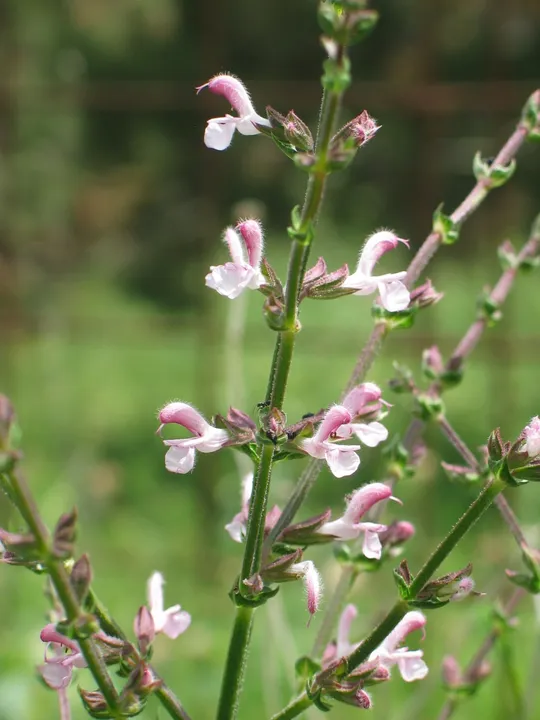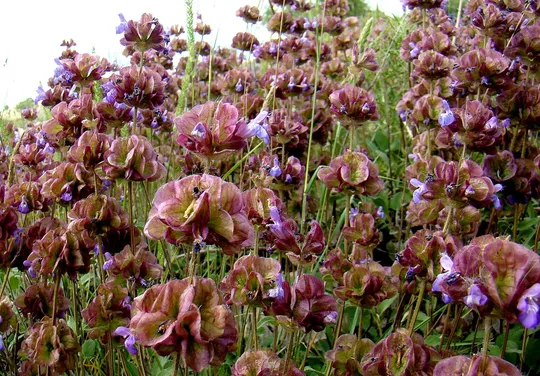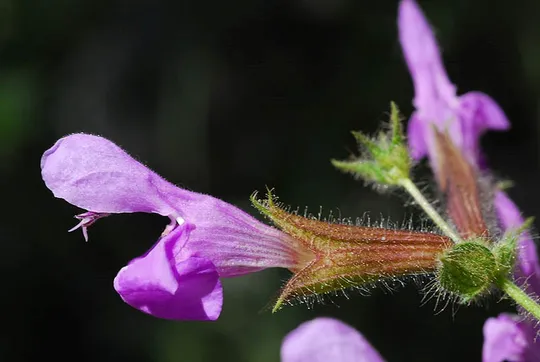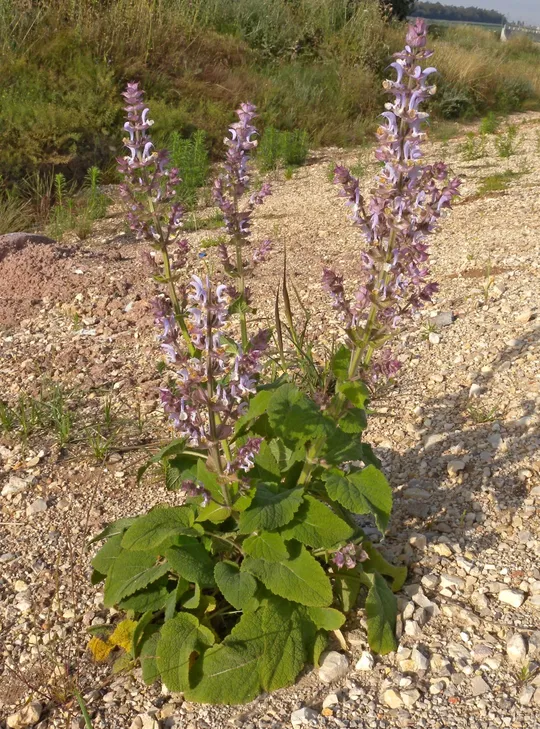Horn-leaved Sage
Salvia ceratophylla
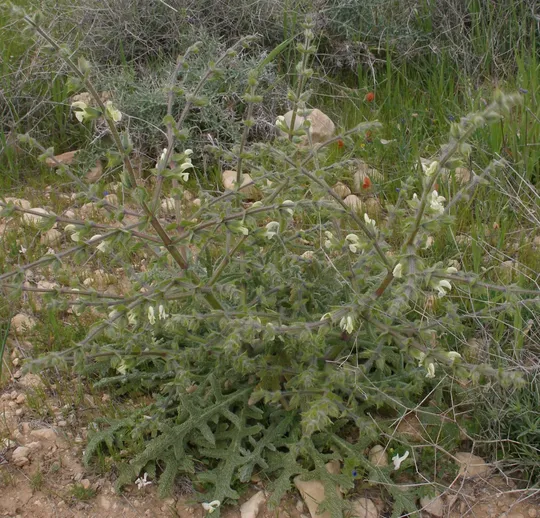
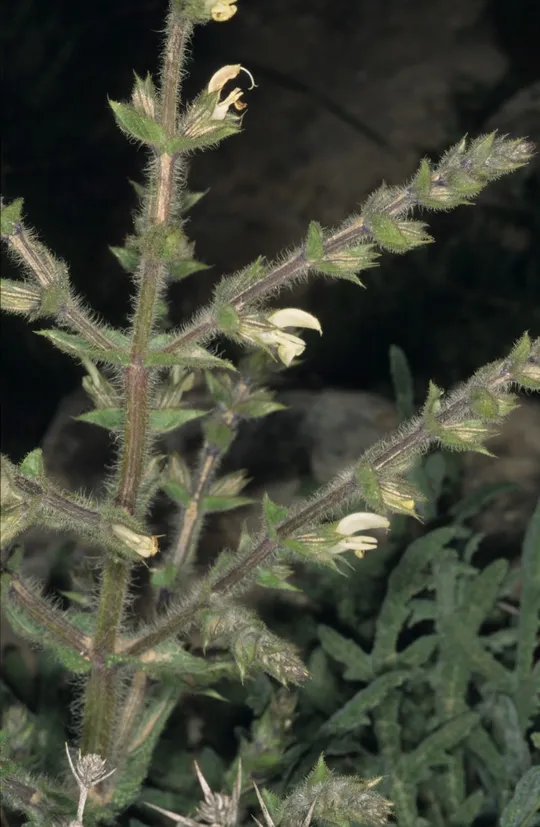
Salvia ceratophylla is found in two
regions in Israel: the Judean Mountains and the Judean Desert, where it grow on
four relatively close sites near the area in which these regions meet. In the
Judean Mountains, it is found at one site at Mitspe Ya'ir in the southern Hebron
Mountains on the Ma'on Ridge. The three Judean Desert sites are from the Tel
Arad and Mount Amasa area. The Flora Palaestina notes that the species is also
found in the lower Jordan Valley and the Golan, however, no evidence of this was
found.
High altitude transition
zone scrubland in the Sarcopoterium spinosum plant association, on chalk
and on the edges of agricultural fields on loess soil. Throughout its entire
range, Salvia ceratophylla grows on arid
rocky, sunny slopes, and in fallow and traditionally cultivated fields.
Salvia ceratophylla belongs to the
section Aethiopis in the genus
Salvia. There are tens of
species in this section, mostly white-flowered herbaceous perennials, found in
the Mediterranean Basin and eastwards to Central Asia. There are several
species from this section in Israel: S. syriaca, that grows in deep soil
and has small flowers and tuberculate leaves; S. spinosa, a desert plant with entire
leaves; S.
palaestina,
a plant of the Mediterranean mountain peaks with dissected leaves and
membranous inflorescence leaves; S. sclarea (see record in this book); S. samuelssonii, a plant characteristic of the
transition zone, with green inflorescence
leaves and large calyxes; S. microstegia, characteristic of high mountains (Hermon, etc.) with violet
glandular hairs on the corolla; S. dominica, an aromatic dwarf shrub and S. indica
with blue-purple flowers. Most of these species, including S. ceratophylla,
are widely distributed over the Middle East and beyond it. Most of them
disappear completely or almost completely in the dry summer and bloom with the
arrival of autumn rains. Some disappear in the cold winter in cold and snowy
areas, and bloom only following the spring thaw in April.
·
Salvia ceratophylla grows at a few
sites in the southern Hebron Mountains and the vicinity of Tel Arad, constituting
an isolated enclave separate from its global range. These sites are apparently
stable, as Eig already collected specimens in 1922 from Tel Arad.
·
Traditional agriculture in the area is
disappearing and there is concern that changes in land use designation of
fallow fields and the transition to modern agriculture in transition zones will
endanger S. ceratophylla populations.
·
S. ceratophylla grows on Mount
Amasa near the Tel Krayot Reserve.
·
S. ceratophylla has a broad geographic
range and it is not globally endangered.
Traditional agriculture should be maintained in the transition
zones of the southern Hebron Mountains and Amasa Mountain and the field edges
and fallow fields should be preserved in these places.
Salvia ceratophylla grows in the
mountains of the Middle East and eastwards to Central Asia, in Israel, Jordan,
Syria, Central Turkey, Armenia, Azerbaijan, Iran and Afghanistan (Gabrielian
& Fragman-Sapir, 2008).
Salvia ceratophylla is a perennial
grass with an ephemeral shoot that grows on fallow fields and field edges in
the Ma'on region transition zone and north of Tel Arad. It is extremely rare in
Israel, but has a broad global distribution.
Gabrielian, E. and Fragman-Sapir, O. 2008. Flowers of the Transcaucasus. A.R.G. Gartner Verlag K.G. pp. 242-243.
Current Occupancy Map
| 1000 squre meter pixel | 5000 squre meter pixel | 10000 squre meter pixel | |
|---|---|---|---|
| number of observations | 0 | 0 | 0 |
| in total pixels | 0 | 0 | 0 |
| Family | Lamiaceae |
| Classification | On the endangered species list |
| Ecosystem | High Semi-Steppe |
| Chorotype | Western Irano – Turanian |
| Conservation Site | Havat Maon |
| Rarity |
1
5
6
|
|---|---|
| Vulnerability |
0
0
4
|
| Attractiveness |
0
2
4
|
| Endemism |
0
0
4
|
| Red number |
1
3.7
10
|
| Peripherality | 0 |
| IUCN category | DD EW EX LC CR EN VU NT |
| Threat Definition according to the red book | Vulnerable |
 Based on:
Based on:
